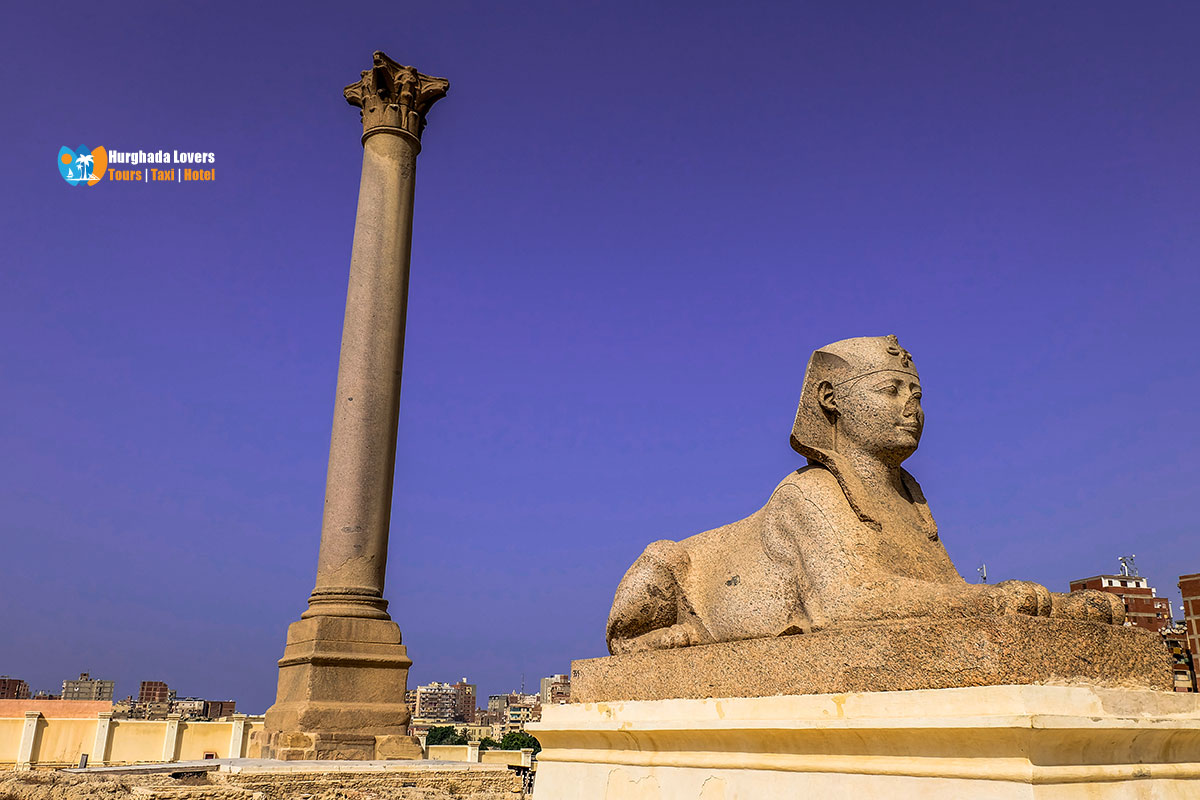Pompey’s Pillar or (the Masts’ Pillar), in Alexandria Egypt | Egypt Archaeological Sites
Discover the history of the Pharaonic civilization and the most important tourist attractions in ancient Alexandria.
Valuable information about Pompey’s Pillar, the most famous Pharaonic Egyptian Monuments, the history of the Ancient Egypt civilization surrounding the Pompey’s Pillar, the reason for the name, ticket prices, working hours, and the administrative structure to start your tourist trip to the distinctive tourist attractions in Egypt.
Pompey’s Pillar Facts
The Pompey’s Pillar was built in 292 AD in honor of the Roman Imperator Diocletian, the most famous king of the Roman era in the era of the Roman Kingdom “Greek-Roman era“.
It was built by the people of Alexandria at the time. The column is located in the middle of the Serapeum Temple on the Bab Sidra hill, between the Egyptian Tombs and the Catacombs of Kom El Shoqafa.
The story begins when the people of Alexandria revolt against Roman rule and a major revolution occurs, which prompted Emperor Diocletian to bring in the army and completely besiege the city. The city surrendered due to lack of food and supplies, but the emperor distributed wheat for free to the people of Alexandria instead of killing or punishing the people..
He also granted a full pardon to the detainees and rioters and lifted the siege. The people of Alexandria built this column in gratitude for what he had done. It was built by the commander Domitianus or Achilles..
The length of the mast column is approximately 27 meters, the diameter of the column from the bottom is approximately 270 cm, its overall diameter is 230 cm, and the top is in the cornice style, in addition to being made of pink granite..
We will find the remains of the memorial text on the base of the column to glorify the role of the emperor and to dedicate it to him and immortalize his memory, in addition to a group of stones from the era of The New Kingdom of Egypt under the name of King Ramses II, one of the famous Egyptian Pharaohs kings of the Nineteenth Dynasty of Egypt “He has the Tomb of King Ramesses II | KV7 within the tombs of the Valley of the Kings in Luxor“.
On the back of the base of the Pompey’s Column you will see a group of stones bearing the names of the kings of the New Kingdom Pharaohs, such as King Ramses II, King Seti II, and king Merneptah.
You will see a staircase made of rock connecting Pompey’s column to the large courtyard and an altar in the middle of the courtyard in addition to a group of catacombs in the rock for long distances, as the catacombs were used to store the artifacts of the Great Serapeum Temple in addition to gaps in the wall to preserve the Ancient Egyptian Papyrus as a small library and to add small statues.
The monuments surrounding the mast column:
Pharaonic Scarab were discovered from granite, “the most famous Ancient Egyptian Metallurgy”, dating back to the 19th Dynasty in the New Kingdom, in addition to 3 statues in the form of a Sphinx made of pink granite and another made of black granite, but you will find that its head is dilapidated and one of them is missing, as it bears the name of King Horemheb from the Eighteenth Dynasty of Egypt.
You will see 3 statues made of pink granite of King Psamtik I of the Twenty-Sixth Dynasty of Egypt of the Late Period, in addition to a statue of King Ramses II, one of the kings of the ancient Egyptian civilization, sitting on the throne and holding a scepter in one of his hands to indicate that he received the Coronation of the Pharaohs and rule in ancient Egypt “Ancient Egyptian Government“, and another statue of King Ramses II made of black granite..
Egyptology and Egyptologists have discovered that the reason for the presence of Egyptian Pharaonic antiquities next to the Pompey’s Pillar is that Queen Cleopatra VII, the most famous Pharaonic queen of Egypt “Female Pharaohs” from the Ptolemaic Kingdom, presented them as offerings to the Temple of Rapis, known as the Serapeum..
The reason for calling it the mast column:
It was called by this name in the Arab era due to the towering height of all the columns around it, which resemble the masts of sea ships. Then it was called the Mast Column, and the name was changed after that. Fishermen coming from the sea from far distances would see the column as a mast in the middle of a group of columns..
It is believed that the Roman leader Pompey was buried and that his ashes are in a vessel at the top of the column, so it was called the Pillar of Pompey. However, it was later discovered that the correct name for the column is the Pillar of Pompey, as the column was built in 291 BC and the leader Pompey died in 300 BC, so it was impossible to keep his head until that time.
It was called the Pompeii Pillar by the Crusaders during their invasion of Egypt..
Who built the mast column?
Commander Domitianus with the people of Alexandria
History of the discovery of the mast column
Working hours
You can visit the archaeological site from 9 am to 5 pm.
Ticket prices
The price of the entrance ticket to the Pompey’s Pillar starts from 20 Egyptian pounds per person.
Note: Facts and secrets of the history will be added soon…
Hurghada Excursions Lovers, Best Travel Agency in Hurghada to provide daily tours to visit the Tourist attractions of Luxor by Hurghada to Luxor Tours and Hurghada to Pyramids Trips. Book online when you come to Hurghada, El Gouna, Sahl Hashish, Makadi Bay, Soma Bay.
Pompey’s Pillar Alexandria | History The Masts’ Pillar column in Egypt

